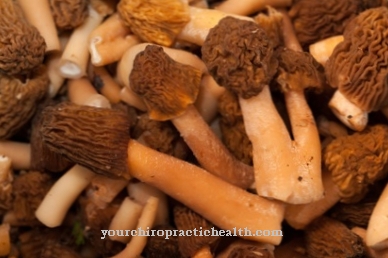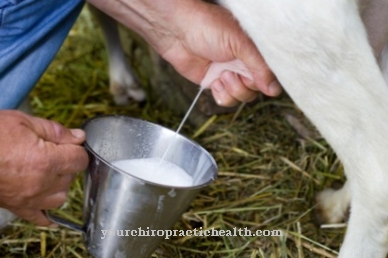The carrot is one of the most famous types of vegetables on the plate these days. It is not for nothing that per capita consumption in Germany averages 6.5 kilograms. The excellent healthy properties and the good tolerance are just two of the positive features.
What you should know about the carrot

The scientific name of the carrot is Daucus carota subsp. sativus. In addition, the carrot experiences such a wide variety of names. Next carrot, carrot, Yellow turnip and Carrots there are numerous other regionally coined terms.
The wild carrot was first mentioned around 60 AD as a medicinal plant. The origin came from different origins - mainly from the Mediterranean area, Afghanistan and Asia Minor. The vegetable belongs to the umbelliferae family. Only the beet is used, which has different shapes and colors depending on the variety. The carrot is a biennial plant that develops a rosette of leaves and a taproot in the first year. In the second year the stem axis is extended and a flower-bearing stem emerges.
There are around 300 different types of carrots in Europe, and they have undergone intensive changes in breeding since 1900. Carrots thrive best in temperate zones, but also in subtropical areas. High yields are more likely to be achieved in areas with an average temperature of 16 to 18 degrees. A carrot consists of the crown, the bark, the cork layer as well as adventitious roots and the pulp inside. Depending on the variety, the shape of the beet is different. Long to short, round and conical to name a few. The same goes for the color of the beet. The best known in this country is the orange carrot.
But the older purple and white varieties are also finding their way back into modern kitchens. The different colors determine, among other things, the variety, the weather and the existing ingredients such as carotenoids, anthocyanins and chlorophyll. There are also several types of cultivation in relation to the seasons: early varieties, summer carrots and late winter carrots. The long shelf life and the possibility of harvesting the carrots almost all year round have made carrots extremely important in the daily diet. With its mild and sweet taste, the carrot is also an ideal vegetable for babies and toddlers as well as in the diet kitchen.
Importance to health
The substances carotene, vitamin C, potassium and iron they contain are of the greatest importance for health. The ingredients in carrots promote blood formation on the one hand, and they also have a positive effect on tooth formation and the body's resistance to infections and diseases.
The potassium content has a diuretic effect. Whoever drinks carrot juice regulates the secretion of gastric juice. Due to the pectin content in the vegetables and the essential oils, the carrot can be used very well for digestive disorders of small children. In order for the antioxidant effect of beta-carotene to work fully, carrots should always be eaten in conjunction with fats or oils. This enables the body to better process this important substance, which is said to bind free radicals. It also has a positive effect on eyesight and helps with cell renewal in the skin.
To meet the daily requirement of vitamin A, it is enough to consume a medium carrot. There are already studies that indicate that the falcarinol it also contains should protect against cancer.
Ingredients & nutritional values
| Nutritional information | Amount per 100 gram |
| Calories 41 | Fat content 0.2 g |
| cholesterol 0 mg | sodium 69 mg |
| potassium 320 mg | carbohydrates 10 g |
| protein 0.9 g | vitamin C 5.9 mg |
In the carrot, most of the important ingredients are found in the rind. The pulp, which can be recognized by its lighter color, has a lower content of substances such as carotene or sucrose. The nitrate content is highest in the innermost part of the carrot. There are 26 calories for every 100 grams of carrots.
About 88 percent of the carrot consists of water, plus 0.98 grams of protein and only 0.2 grams of fat. It contains vitamins: B1, B2, B6, C, E. Other important ingredients are calcium, iron, magnesium, phosphorus, potassium and zinc. The secondary plant substances carotene is of great importance. He is responsible for the color of the carrot. In addition to the sugar contained, the essential oils and fruit acids are responsible for the taste. (for example malic acid or citric acid)
Intolerances & allergies
Cooked carrots are usually well tolerated because the heat destroys existing allergens. Unfortunately, this does not apply to raw carrots. Food allergies are quite common here. Complaints usually arise immediately after consumption.
For example, asthma, shortness of breath, itching, runny nose, swelling, digestive problems or neurodermatitis speak for an allergy. So-called cross allergies in connection with birch pollen, celery and mugwort are also possible. A possible therapy is to avoid the foods that trigger the allergy. Acupuncture or homeopathic remedies, which are used to minimize intolerance, are also helpful.
Shopping & kitchen tips
If you cannot or do not want to grow your carrots yourself, pay attention to a thinner, elongated shape when buying carrots. The less pronounced the inner core of the carrot, the more important and healthy ingredients are retained.
Bunch carrots bought with greens should be consumed quickly and directly. The green is removed as it removes water from the beets. Fresh carrots can be kept in the refrigerator's vegetable compartment for a maximum of ten days. These are thoroughly washed and brushed off before consumption. It is not necessary to peel the carrots, as this will remove many of the good ingredients. Carrots have an excellent shelf life. Winter carrots harvested late will keep in optimal storage conditions (preferably in moist sand and well ventilated) in the cellar until next spring.
Packaged carrots, so-called washed carrots, remain edible for several months. However, these have less sugar and lose more and more of their valuable ingredients over time. Another way of preservation is freezing. Shortly blanched carrots can be stored in the freezer for many months. They lose some of their taste, but none of their quality. Other variations include soaking carrots in vinegar, water and spices and juicing the vegetables.
Preparation tips
There are more different ways to prepare the carrot than almost any other type of vegetable. Raw in a salad in combination with apples and other fruit or cooked or steamed as a vegetable side dish, it goes well with many different dishes.
The cooking time of carrots is 12 to 18 minutes. Care should be taken to ensure that the temperature is not too high so that as many of the ingredients as possible are retained. Carrot juice is also popular, as it is said to have a number of positive health benefits.When steamed and mashed briefly, the carrot is one of the first foods that babies and toddlers like to use when they are older.













.jpg)

.jpg)
.jpg)











.jpg)